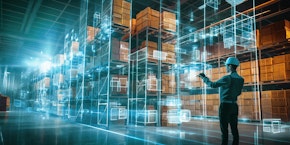The top logistics trends in 2024 and beyond

The logistics industry continues to be shaped by powerful disruptive forces and megatrends such as climate change, the pandemic, war and urbanisation. These forces are rapidly increasing the speed of transformation in the world of logistics. In its latest Logistics Trends Radar (1), DHL evaluated a total of 40 trends in the areas of "Social and Business" and "Technology" that will have a major impact on logistics and supply chains in the coming years. According to their research, trends already manifesting themselves that will have an enormous impact on supply chains are in the area of "Social and Business". Examples of areas affected include omnichannel logistics, digital marketplaces, diversification of supply chains, the circular economy, sustainability and decarbonisation. In the technology area, it is big data analytics, edge computing, stationary robotics, automated guided vehicles (AGVs) for intralogistics, autonomous vehicles for outdoor use and alternative energy solutions. Trends and challenges influencing the transformation of warehousing and operations are analysed in more depth in the Warehouse Vision Study (2) by Zebra Technologies Corp. Some of these trends are discussed below.
Crises lead to diversification of supply chains
The pandemic and the Russian-Ukrainian war have taught the logistics industry the importance of resilient supply chains and supply chain management. An important factor in increasing resilience is the issue of supply chain diversification. By selecting alternative suppliers and expanding the manufacturing and distribution network, the resilience, agility, responsiveness and competitiveness of the supply chain can be increased. Associated concepts here are "multisourcing" and "multishoring". Multishoring meaning cooperation with many, sometimes competing, suppliers, with particular emphasis placed on the fact that the suppliers come from different countries. During the Corona crisis, the heavy dependence on Chinese suppliers had a very negative impact and led to disruptions in the ability to deliver. Digital transformation enables the creation of efficient, global supplier platforms and networks as well as dedicated supply chain management.
The circular economy and decarbonisation
Although sustainability is a high priority for society, according to DHL only 8.5% of well over 100 billion tonnes of consumed materials are recycled and returned to the cycle. In the future, the share of fully recycled products of companies is to be massively increased by strengthening the topic of the circular economy worldwide. In sustainable product design, the entire product life cycle is considered and all materials and components are already intended for recycling and return to the circular economy. Around 80% of a product's environmental impact is already determined at the design stage (3). Existing materials and products are reused, repaired, refurbished, shared, leased and ultimately recycled for as long as possible, maximising the life cycle of the products. In this way, waste is also reduced to a minimum. Unlike the throwaway economy, the circular economy also reduces total annual greenhouse gas emissions. Industrial processes and product use cause 9.1% of greenhouse gas emissions in the EU, according to the European Environment Agency. Waste management generates 3.32%. Already in March 2020, the European Commission published the Circular Economy Action Plan, which contains proposals for more sustainable product design and aims to reduce waste generation.
The objective of decarbonisation is the creation of a carbon-free and climate-neutral economy by 2050. The basis for decarbonisation is the move away from fossil fuels and the use of low-carbon alternative energies. High energy-intensive industries such as steel, glass and building materials production, must switch to carbon-free energy sources as soon as possible. Important milestones of the decarbonisation policy are the Paris Climate Agreement of 2015 and the so-called "European Green Deal". According to this, businesses, industry and the entire economy of the EU are to be climate neutral by 2050 (4). Two-thirds of the CO2 emissions of businesses and industry come from the use of fossil fuels and can therefore be eliminated by switching to greenhouse gas-neutral energies (5).
Edge computing handles big data on site
In edge computing, data processing takes place directly or close to a specific data source (edge of the network), meaning data is therefore not processed in a distant data centre (6). The topic refers to the decentralisation of IT architecture made possible by the Internet of Things (IOT), mobile computing and 5G network. The advantages of edge computing are that companies can gain insights from big data analytics in near real-time with lower latency and cloud server bandwidth. It also requires a much smaller IT infrastructure than traditional cloud computing. Industry 4.0 and the networking of all machines, plants, cyber-physical systems, etc. via IOT will create ever larger amounts of data in the future, which will have to be processed directly on-site by edge computing in the company. It is simply not practical to send such data volumes via the internet to remote cloud computing data centres. As an aside, this even adds an extra layer of security. Edge computing can be used now and in the future for many purposes, also in logistics, such as warehouse robots acting with each other, networking of different company areas such as warehouses and production, autonomous vehicles, predictive maintenance, and much more. Basically, edge computing is useful wherever large amounts of data (big data) are generated in real time. According to the consulting firm ISG, the edge computing market is expected to grow by 30% annually.
Robotics and AGVs in intralogistics increase efficiency
The incredible growth of e-commerce (7) and the huge increase in consumer demand require increasing digitalisation and automation as well as a need to increase the efficiency of intralogistics processes and supply chains. Digitalisation and automation with associated technologies such as 5G, IOT, Artificial Intelligence (AI), Edge Computing will completely transform the logistics industry. In intralogistics, more and more work will be taken over by AGVs (Automated Guided Vehicles) and stationary robots. Indoor mobile robots include AGVs and AMRs (Autonomous Mobile Robots). AMRs, being more advanced than AGVs, use real-time path planning and can avoid obstacles more easily so they are used, for example, in order picking or other transport tasks. Once indoor mobile robots can be used on a large scale, they will prove their enormous potential in reducing costs and increasing efficiency and transform the industry enormously.
With the rapid development of AI technology and sensor technology, stationary robots such as collaborative robots (cobots) and industrial robots are becoming more diverse and versatile. It is expected that in the future there will be an increasing division of labour between humans and cobots. Robots, of course, will mostly be used in repetitive, unchanging processes. The question is how innovations in the field of artificial intelligence will expand the fields of work. AI is also being used in object recognition in particular. But also fields like skill-based robot programming using data gauntlet is a topic that will shape the future (8).
Top issue: shortage of skilled workers
The digital transformation with all its innovations will level out the shortage of skilled workers. There is already a shortage of labour and skilled workers along the supply chain, which is likely to increase in the future due to low birth rates. According to the German Federal Ministry for Economic Affairs and Energy (BMWI), there will be up to a third fewer people in employment by 2060 (9). In logistics, for example, there is a massive shortage of warehouse workers, truck drivers and IT specialists. Digitalisation and automation are meant to remedy this in many places. Automated processes and systems, robots, AGVs, autonomous vehicles, AI and other innovations will replace many skilled workers in the warehouse and along the supply chain. However, it will still take a while before such systems become the standard everywhere.
Literature
1 The Logistics Trends Radar 6.0, 25 October 2022, DHL Trend Research, Link
2 Whitepaper Warehouse Vision Study, Tech that enhances human capabilities and drives modernization, Zebra Technologies Corp, Link
3 Circular Economy: Definition and Benefits, European Parliament, Link
4 BITO Expertise, Sustainability and Greenhouse Gas Protocol, Link
5 Decarbonisation: The way to a carbon-free economy, EHA Energie-Handels-Gesellschaft mbH & Co. KG, Link
6 What is Edge Computing?, Hewlett Packard, Link
7 Global E-Commerce Logistics Market Will Be Worth Over €500bn by 2024, Logistics Brief, Link
8 AI-based human-robot collaboration, Mittelstand Digital, Link
9 Logistics skills shortage: A lot of transport volume with few employees, January 2023, E-Commerce Magazin, Link

